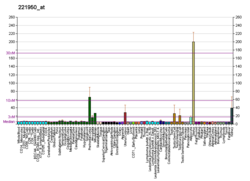Homeobox protein Emx2 is a protein that in humans is encoded by the EMX2 gene.
Function
The homeodomain transcription factor EMX2 is critical for central nervous system and urogenital development. EMX1 (MIM 600034) and EMX2 are related to the 'empty spiracles' gene expressed in the developing Drosophila head..
The EMX2 gene encodes for a transcription factor that is a homolog to Drosophila melanogaster “empty spiracles” gene. The “empty spiracles gene” is needed for the proper head development/formation as well as the development of posterior spiracles in Drosophila melanogaster.
In humans, EMX2 shows high expression in the dorsal telencephalon, olfactory neuroepithelium, as well as the urogenital system. In the developing uroepithelium, EMX2 is negatively regulated by HOXA10. EMX2 has been associated with Schizencephaly, a disease where there are large parts of the brain hemispheres absent and that are replaced with cerebrospinal fluid, clinical observations can include seizures, blindness, and inability to walk/speak. EMX2 has also been shown to have an important role in tumorigenesis. One study found that the expression of EMX2 is significantly decreased in tissues and cells with colorectal cancer. It is suspected that EMX2 could be used as a treatment of colorectal cancer.
See also
References
- ^ GRCm38: Ensembl release 89: ENSMUSG00000043969 – Ensembl, May 2017
- "Human PubMed Reference:". National Center for Biotechnology Information, U.S. National Library of Medicine.
- "Mouse PubMed Reference:". National Center for Biotechnology Information, U.S. National Library of Medicine.
- Kastury K, Druck T, Huebner K, Barletta C, Acampora D, Simeone A, Faiella A, Boncinelli E (Dec 1994). "Chromosome locations of human EMX and OTX genes". Genomics. 22 (1): 41–5. doi:10.1006/geno.1994.1343. PMID 7959790.
- ^ "EMX2 empty spiracles homeobox 2". Entrez Gene.
- Walldorf U, Gehring WJ (June 1992). "Empty spiracles, a gap gene containing a homeobox involved in Drosophila head development". The EMBO Journal. 11 (6): 2247–59. doi:10.1002/j.1460-2075.1992.tb05284.x. PMC 556692. PMID 1376248.
- "Schizencephaly". Genetic Testing Registry (GTR). National Center for Biotechnology Information, U.S. National Library of Medicine.
- Zhang Y, Cao G, Yuan QG, Li JH, Yang WB (April 2017). "Empty Spiracles Homeobox 2 (EMX2) Inhibits the Invasion and Tumorigenesis in Colorectal Cancer Cells". Oncology Research. 25 (4): 537–544. doi:10.3727/096504016X14756640150695. PMC 7841084. PMID 27712600.
Further reading
- Guerrini R, Carrozzo R (2002). "Epileptogenic brain malformations: clinical presentation, malformative patterns and indications for genetic testing". Seizure: The Journal of the British Epilepsy Association. 11 Suppl A (7): 532–43, quiz 544–7. doi:10.1053/seiz.2001.0650. PMID 12185771. S2CID 18943418.
- Simeone A, Gulisano M, Acampora D, et al. (1992). "Two vertebrate homeobox genes related to the Drosophila empty spiracles gene are expressed in the embryonic cerebral cortex". EMBO J. 11 (7): 2541–50. doi:10.1002/j.1460-2075.1992.tb05319.x. PMC 556729. PMID 1352754.
- Brunelli S, Faiella A, Capra V, et al. (1996). "Germline mutations in the homeobox gene EMX2 in patients with severe schizencephaly". Nat. Genet. 12 (1): 94–6. doi:10.1038/ng0196-94. PMID 8528262. S2CID 339074.
- Wiemann S, Weil B, Wellenreuther R, et al. (2001). "Toward a catalog of human genes and proteins: sequencing and analysis of 500 novel complete protein coding human cDNAs". Genome Res. 11 (3): 422–35. doi:10.1101/gr.GR1547R. PMC 311072. PMID 11230166.
- Noonan FC, Mutch DG, Ann Mallon M, Goodfellow PJ (2001). "Characterization of the homeodomain gene EMX2: sequence conservation, expression analysis, and a search for mutations in endometrial cancers". Genomics. 76 (1–3): 37–44. doi:10.1006/geno.2001.6590. PMID 11549315.
- Strausberg RL, Feingold EA, Grouse LH, et al. (2003). "Generation and initial analysis of more than 15,000 full-length human and mouse cDNA sequences". Proc. Natl. Acad. Sci. U.S.A. 99 (26): 16899–903. Bibcode:2002PNAS...9916899M. doi:10.1073/pnas.242603899. PMC 139241. PMID 12477932.
- Troy PJ, Daftary GS, Bagot CN, Taylor HS (2003). "Transcriptional repression of peri-implantation EMX2 expression in mammalian reproduction by HOXA10". Mol. Cell. Biol. 23 (1): 1–13. doi:10.1128/MCB.23.1.1-13.2003. PMC 140663. PMID 12482956.
- Noonan FC, Goodfellow PJ, Staloch LJ, et al. (2003). "Antisense transcripts at the EMX2 locus in human and mouse". Genomics. 81 (1): 58–66. doi:10.1016/S0888-7543(02)00023-X. PMID 12573261.
- Ota T, Suzuki Y, Nishikawa T, et al. (2004). "Complete sequencing and characterization of 21,243 full-length human cDNAs". Nat. Genet. 36 (1): 40–5. doi:10.1038/ng1285. PMID 14702039.
- Daftary GS, Taylor HS (2004). "EMX2 gene expression in the female reproductive tract and aberrant expression in the endometrium of patients with endometriosis". J. Clin. Endocrinol. Metab. 89 (5): 2390–6. doi:10.1210/jc.2003-031389. PMID 15126568.
- Nédélec S, Foucher I, Brunet I, et al. (2004). "Emx2 homeodomain transcription factor interacts with eukaryotic translation initiation factor 4E (eIF4E) in the axons of olfactory sensory neurons". Proc. Natl. Acad. Sci. U.S.A. 101 (29): 10815–20. Bibcode:2004PNAS..10110815N. doi:10.1073/pnas.0403824101. PMC 490017. PMID 15247416.
- Hamasaki T, Leingärtner A, Ringstedt T, O'Leary DD (2004). "EMX2 regulates sizes and positioning of the primary sensory and motor areas in neocortex by direct specification of cortical progenitors". Neuron. 43 (3): 359–72. doi:10.1016/j.neuron.2004.07.016. PMID 15294144. S2CID 14259180.
- Treloar SA, Zhao ZZ, Le L, et al. (2007). "Variants in EMX2 and PTEN do not contribute to risk of endometriosis". Mol. Hum. Reprod. 13 (8): 587–94. doi:10.1093/molehr/gam023. PMID 17563403.
External links
- EMX2+protein,+human at the U.S. National Library of Medicine Medical Subject Headings (MeSH)
This article incorporates text from the United States National Library of Medicine, which is in the public domain.
| Transcription factors and intracellular receptors | |||||||||||||||||||||||||||||||
|---|---|---|---|---|---|---|---|---|---|---|---|---|---|---|---|---|---|---|---|---|---|---|---|---|---|---|---|---|---|---|---|
| |||||||||||||||||||||||||||||||
| |||||||||||||||||||||||||||||||
| |||||||||||||||||||||||||||||||
| |||||||||||||||||||||||||||||||
| |||||||||||||||||||||||||||||||
| see also transcription factor/coregulator deficiencies | |||||||||||||||||||||||||||||||
This article on a gene on human chromosome 10 is a stub. You can help Misplaced Pages by expanding it. |


